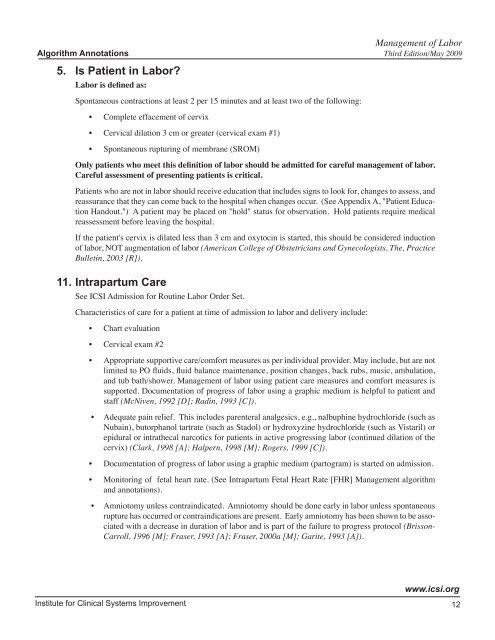Management of Labor
Management of Labor
Management of Labor
Create successful ePaper yourself
Turn your PDF publications into a flip-book with our unique Google optimized e-Paper software.
<strong>Management</strong> <strong>of</strong> <strong>Labor</strong><br />
Algorithm Annotations Third Edition/May 2009<br />
5. Is Patient in <strong>Labor</strong>?<br />
<strong>Labor</strong> is defined as:<br />
Spontaneous contractions at least 2 per 15 minutes and at least two <strong>of</strong> the following:<br />
• Complete effacement <strong>of</strong> cervix<br />
• Cervical dilation 3 cm or greater (cervical exam #1)<br />
• Spontaneous rupturing <strong>of</strong> membrane (SROM)<br />
Only patients who meet this definition <strong>of</strong> labor should be admitted for careful management <strong>of</strong> labor.<br />
Careful assessment <strong>of</strong> presenting patients is critical.<br />
Patients who are not in labor should receive education that includes signs to look for, changes to assess, and<br />
reassurance that they can come back to the hospital when changes occur. (See Appendix A, "Patient Education<br />
Handout.") A patient may be placed on "hold" status for observation. Hold patients require medical<br />
reassessment before leaving the hospital.<br />
If the patient's cervix is dilated less than 3 cm and oxytocin is started, this should be considered induction<br />
<strong>of</strong> labor, NOT augmentation <strong>of</strong> labor (American College <strong>of</strong> Obstetricians and Gynecologists, The, Practice<br />
Bulletin, 2003 [R]).<br />
11. Intrapartum Care<br />
See ICSI Admission for Routine <strong>Labor</strong> Order Set.<br />
Characteristics <strong>of</strong> care for a patient at time <strong>of</strong> admission to labor and delivery include:<br />
• Chart evaluation<br />
• Cervical exam #2<br />
• Appropriate supportive care/comfort measures as per individual provider. May include, but are not<br />
limited to PO fluids, fluid balance maintenance, position changes, back rubs, music, ambulation,<br />
and tub bath/shower. <strong>Management</strong> <strong>of</strong> labor using patient care measures and comfort measures is<br />
supported. Documentation <strong>of</strong> progress <strong>of</strong> labor using a graphic medium is helpful to patient and<br />
staff (McNiven, 1992 [D]; Radin, 1993 [C]).<br />
• Adequate pain relief. This includes parenteral analgesics, e.g., nalbuphine hydrochloride (such as<br />
Nubain), butorphanol tartrate (such as Stadol) or hydroxyzine hydrochloride (such as Vistaril) or<br />
epidural or intrathecal narcotics for patients in active progressing labor (continued dilation <strong>of</strong> the<br />
cervix) (Clark, 1998 [A]; Halpern, 1998 [M]; Rogers, 1999 [C]).<br />
• Documentation <strong>of</strong> progress <strong>of</strong> labor using a graphic medium (partogram) is started on admission.<br />
• Monitoring <strong>of</strong> fetal heart rate. (See Intrapartum Fetal Heart Rate [FHR] <strong>Management</strong> algorithm<br />
and annotations).<br />
• Amniotomy unless contraindicated. Amniotomy should be done early in labor unless spontaneous<br />
rupture has occurred or contraindications are present. Early amniotomy has been shown to be associated<br />
with a decrease in duration <strong>of</strong> labor and is part <strong>of</strong> the failure to progress protocol (Brisson-<br />
Carroll, 1996 [M]; Fraser, 1993 [A]; Fraser, 2000a [M]; Garite, 1993 [A]).<br />
Institute for Clinical Systems Improvement<br />
www.icsi.org<br />
12
















